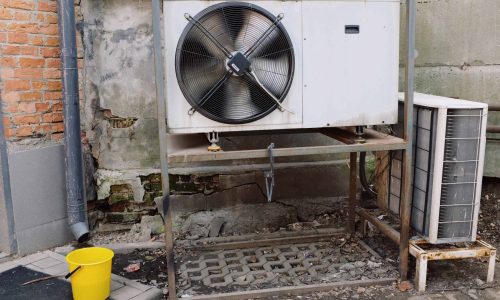In commercial buildings, the HVAC system is one of the most significant energy consumers. Building owners and facility managers are constantly seeking ways to improve energy efficiency and reduce utility costs without compromising indoor comfort. One way to achieve this is through the use of VAV systems. However, few homeowners know what is a VAV in HVAC and the benefits they have often go unheard of as a resuly
Simply put, a VAV system is an HVAC system that uses dampers to regulate the airflow to different zones or rooms based on their heating or cooling requirements. By delivering the precise amount of conditioned air to each zone, VAV systems optimize energy usage, reduce waste, and enhance indoor comfort.
In this article, we’ll explore the benefits of VAV systems and how they improve energy efficiency in HVAC. Once you’ve made the choice to upgrade or install, just call River Valley Air Conditioning, Inc for help
Understanding Variable Air Volume (VAV)

If you’re interested in learning what does VAV mean in HVAC, you might be surprised at its simplicity. A Variable Air Volume – or a VAV system – is a type of HVAC system that regulates the flow of conditioned air based on the specific needs of different zones or areas within a building. Unlike constant volume systems, where the airflow remains constant regardless of demand, VAV systems adjust the airflow to match the thermal requirements of each space.
By adjusting the airflow to match the demand of each zone, VAV systems optimize energy usage, improve comfort, and allow for individualized temperature control. These systems are commonly used in commercial buildings where flexibility, energy efficiency, and comfort are paramount
How Does VAV Improve Energy Efficiency?
By supplying the precise amount of conditioned air required, VAV systems minimize energy waste and reduce the load on the HVAC system. The ability to zone different areas allows for targeted temperature control, preventing over-conditioning and optimizing energy usage.
Additionally, VAV systems often incorporate energy-saving features such as demand-based control, variable fan speeds, and the ability to integrate with building automation systems, further enhancing their energy efficiency capabilities. This makes energy efficiency one of the best ways to tell what is a VAV HVAC system when you aren’t sure
Demand-Based Control
Demand-Based Control is a feature of VAV systems that enhances energy efficiency by modulating the heating or cooling output based on actual demand. This feature works by using sensors to measure the temperature and humidity levels in each zone or room and adjusting the airflow and temperature output accordingly. When a space is unoccupied, the system can reduce the heating or cooling output to save energy.
Alternatively, the system can increase the output when the demand is high, such as during peak occupancy hours. By matching the HVAC output to the actual demand, VAV systems can save energy and reduce wear and tear on the equipment, ultimately extending the lifespan of the system. Demand-based control is also beneficial for improving indoor comfort by providing optimal temperature and humidity levels based on actual usage.
Zoning and Occupancy Sensing
VAV systems divide a building into multiple zones, each with its own temperature control. Through the use of thermostats and sensors, the system can detect temperature variations and occupancy levels in different zones. This zoning capability allows for customized temperature control in each area, avoiding the need to cool or heat the entire building uniformly. Consequently, energy is conserved by delivering conditioned air only where and when it is needed.
Variable Fan Speed
HVAC systems with variable fan speeds can adjust the fan speed based on the demand for heating or cooling. By using sensors to monitor the temperature and humidity levels in each zone or room, the system can adjust the fan speed to match the actual demand, delivering just the right amount of conditioned air to maintain the desired temperature. This can result in significant energy savings, as the system is not running at full capacity when it is not necessary.
Another benefit of variable fan speeds is improved indoor air quality. By delivering the right amount of conditioned air to each zone or room, the system can better regulate humidity levels and prevent the buildup of contaminants in the air. This can improve employee productivity, reduce the risk of illnesses, and enhance customer satisfaction.
In a VAV system, the fan speed can be adjusted based on the demand for airflow. By operating at lower speeds when the demand is low, VAV systems reduce fan energy consumption. This modulation ensures that the fan consumes only the necessary power to maintain the desired airflow, resulting in energy savings.
Energy Recovery

Energy recovery systems offer several benefits. First, they help maintain a comfortable indoor environment by efficiently controlling temperature and humidity levels. This contributes to occupant satisfaction and productivity. Second, energy recovery reduces the environmental impact associated with HVAC systems. By maximizing the use of available energy, it minimizes the need for additional energy generation, thus reducing greenhouse gas emissions.
In commercial buildings with high ventilation requirements, such as offices, hospitals, or educational institutions, energy recovery systems are particularly advantageous. They can recover and reuse energy from exhaust air, transferring it to the incoming fresh air stream. This process helps to maintain a balanced and energy-efficient indoor environment, even during periods of high ventilation demand.
What is a VAV in HVAC can also be described by how it can incorporate energy recovery mechanisms such as heat exchangers or heat recovery ventilators (HRVs). These devices capture and transfer energy from the exhaust air to the incoming fresh air, pre-conditioning the air and reducing the load on the heating or cooling equipment. By recovering and reusing energy that would otherwise be wasted, VAV systems enhance energy efficiency and reduce operating costs.
Integrated Controls and Automation
Integrated controls and automation play a crucial role in optimizing the performance of HVAC systems, resulting in improved energy efficiency, cost savings, and enhanced occupant comfort. Integrated controls and automation refer to the use of advanced technologies to monitor and control HVAC systems, including heating, cooling, ventilation, and lighting.
Integrated controls and automation systems can further help reduce operational costs by optimizing energy consumption. By monitoring energy usage and identifying inefficiencies, these systems can adjust HVAC settings to minimize energy waste and reduce utility bills.
VAV systems often utilize advanced control technologies and building automation systems to optimize energy efficiency. These systems monitor and adjust various parameters, including temperature, humidity, occupancy, and outdoor conditions, in real-time. Through integrated controls, VAV systems can dynamically adapt to changing environmental conditions and occupant requirements, ensuring efficient operation and minimizing energy waste.
Benefits of VAV Systems
The above mentioned methods of energy efficiency are just a few of the potential benefits. These systems offer enhanced comfort by allowing individual temperature control in different areas, ensuring occupants’ preferences are met. VAV systems also contribute to better indoor air quality by regulating airflow and incorporating fresh air ventilation, reducing the presence of contaminants.
Additionally, their flexibility and zoning capabilities make them adaptable to various building layouts and occupancy patterns, while their quieter operation enhances the overall indoor environment. If you aren’t sure if you have one of these systems, these benefits – some of which we’ve gone deeper into – can show homeowners what is a VAV box in HVAC.
Occupancy and Demand-based
Control VAV systems can incorporate occupancy sensors or demand-based control strategies to further optimize energy efficiency. By detecting occupancy levels in different zones, the system can adjust airflow and temperature settings accordingly, avoiding unnecessary cooling or heating when spaces are unoccupied.
Improved Comfort
VAV systems provide enhanced comfort for building occupants. With individual zone control, each area can maintain its desired temperature independently. This customization ensures that occupants are comfortable in their respective zones, regardless of variations in temperature preferences or occupancy levels in other parts of the building.
Enhanced Indoor Air Quality
Another way to understand what is a VAV in HVAC is by seeing how it can contribute to improved indoor air quality. By regulating airflow and providing fresh air ventilation to each zone, these systems can help remove contaminants and maintain a healthier indoor environment. The ability to adjust airflow rates based on occupancy and air quality needs allows for efficient ventilation and filtration, reducing the risk of airborne pollutants and allergens.
Energy Efficiency
VAV systems are designed to provide precise control of airflow and temperature to each zone or room. By delivering the right amount of conditioned air based on the specific requirements of each zone, VAV systems minimize energy waste and improve overall energy efficiency. The ability to adjust airflow reduces the load on the HVAC system, resulting in lower energy consumption and reduced operating costs.
Cost Savings

Due to their energy-efficient operation, VAV systems can lead to significant cost savings. By optimizing the use of conditioned air and avoiding unnecessary cooling or heating of unoccupied areas, VAV systems reduce the overall energy demand and can result in lower utility bills. Additionally, the ability to zone different areas allows for more targeted temperature control, preventing over-conditioning and optimizing comfort levels while minimizing energy expenditure.
Takeaway
Variable Air Volume or VAV systems are an important component of HVAC systems that significantly improve energy efficiency. By regulating airflow and temperature based on the specific heating or cooling requirements of each zone or room, VAV systems optimize energy usage, reduce waste, and lower utility costs. The ability to individually control zones allows for targeted temperature adjustments, preventing over-conditioning and ensuring occupant comfort while minimizing energy consumption.
Additionally, VAV systems often incorporate demand-based control, variable fan speeds, and zoning capabilities, further enhancing their energy efficiency capabilities. With their ability to provide precise control and adaptability to varying occupancy patterns, VAV systems are an effective solution for achieving energy efficiency in HVAC systems, benefiting both building owners and occupants alike.
If you’re interested in getting your own VAV system or upgrading to one, our team at River Valley Air Conditioning Inc is ready to help. All you need to do is call us!
